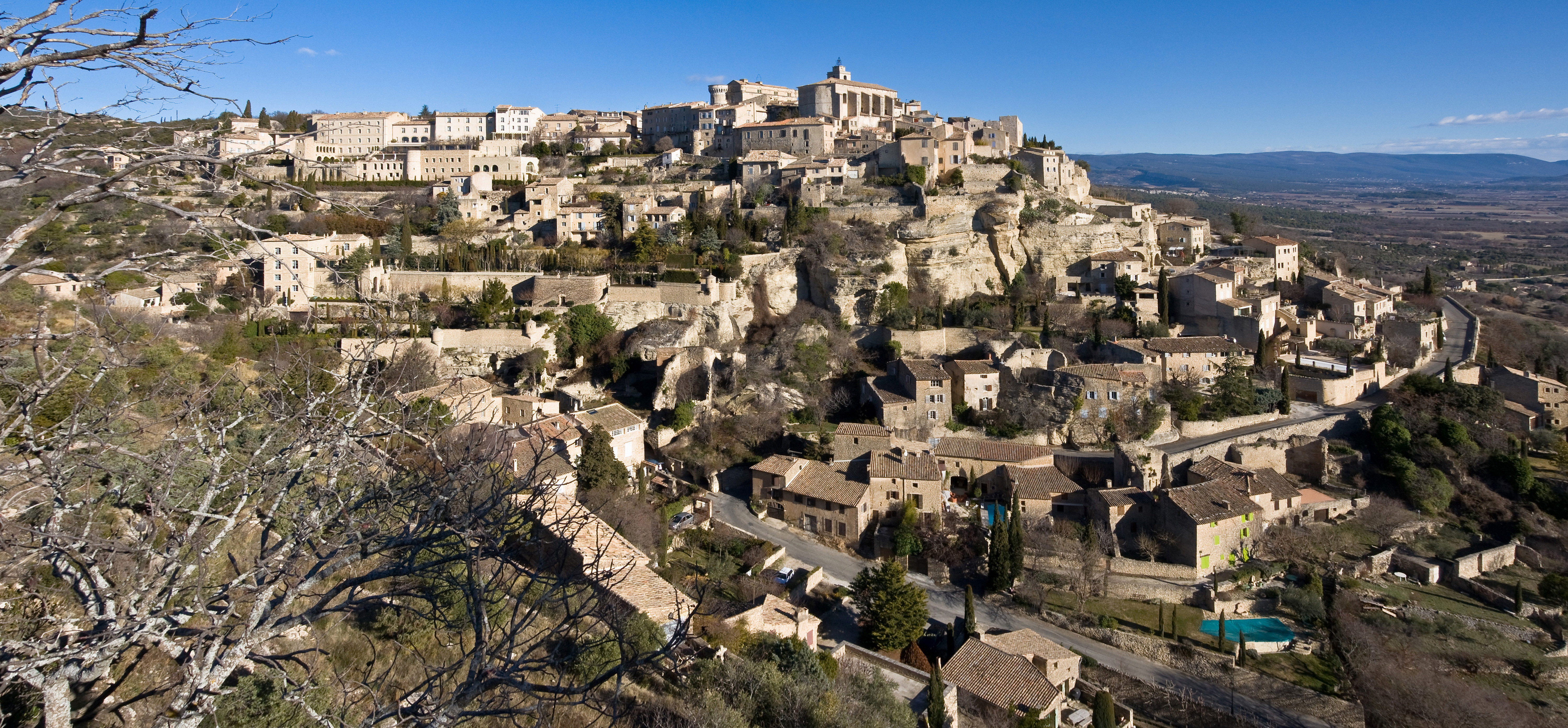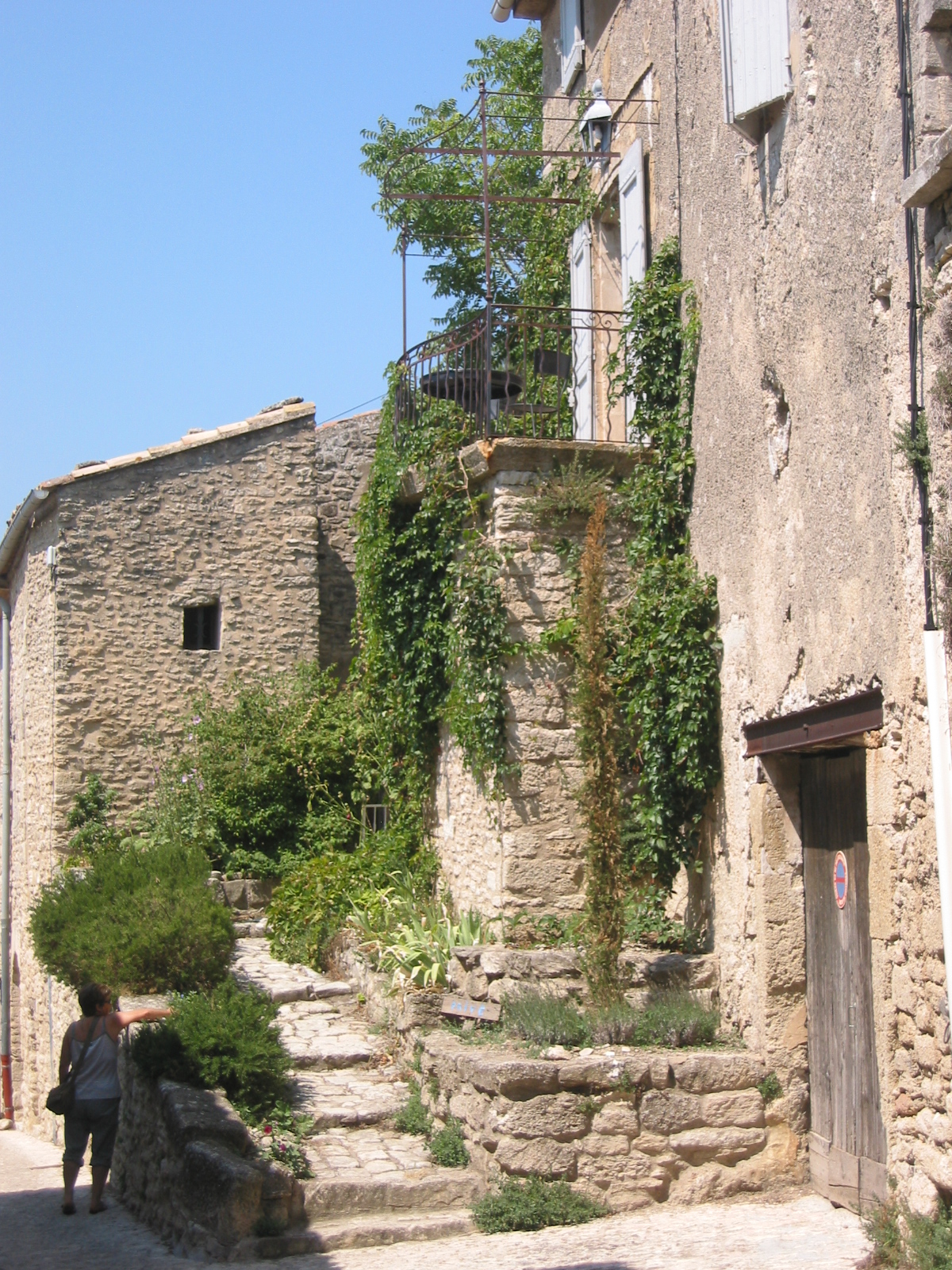Village Perché on:
[Wikipedia]
[Google]
[Amazon]
 A village perché is a village perched at the top of a
A village perché is a village perched at the top of a
 'Villages perchés' are found mainly in hilly areas where soil is poor and water scarce. This is generally case in Provence except in the lower Rhone valley and in the Durance valley, where alluvial land abounds and water is easily accessible from a well dug in the courtyard of the house.
Moreover, this grouping in a community closed in on itself corresponds to regions of small properties, where the only fertile lands are situated at the bottom of a few valleys, and this aggregation has facilitated the existence of rural handicraft indispensable to the villagers. Conversely, the dispersed habitat implies larger, wealthier estates, hence the aphorism penned by Fernand Benoit: "Poverty concentrates the habitat, wealth disperses it".
'Villages perchés' are found mainly in hilly areas where soil is poor and water scarce. This is generally case in Provence except in the lower Rhone valley and in the Durance valley, where alluvial land abounds and water is easily accessible from a well dug in the courtyard of the house.
Moreover, this grouping in a community closed in on itself corresponds to regions of small properties, where the only fertile lands are situated at the bottom of a few valleys, and this aggregation has facilitated the existence of rural handicraft indispensable to the villagers. Conversely, the dispersed habitat implies larger, wealthier estates, hence the aphorism penned by Fernand Benoit: "Poverty concentrates the habitat, wealth disperses it".
 There is a specific habitat type that is linked to the village perché: the 'high house'. Benoit explains that "its originality consists in placing the beasts below, man above." The building is subdivided into a barn on the ground floor, housing on one or two floors, and an attic. It was the type of house reserved for the peasant villagers who had little livestock to accommodate. It is still found today in a number of mountainous massifs of western Provence, including the Alps valleys of
There is a specific habitat type that is linked to the village perché: the 'high house'. Benoit explains that "its originality consists in placing the beasts below, man above." The building is subdivided into a barn on the ground floor, housing on one or two floors, and an attic. It was the type of house reserved for the peasant villagers who had little livestock to accommodate. It is still found today in a number of mountainous massifs of western Provence, including the Alps valleys of
Ansouis 7.jpg,
 A village perché is a village perched at the top of a
A village perché is a village perched at the top of a relief
Relief is a sculptural method in which the sculpted pieces are bonded to a solid background of the same material. The term '' relief'' is from the Latin verb ''relevo'', to raise. To create a sculpture in relief is to give the impression that th ...
, most commonly found in France. Naturally difficult to access, often with ramparts, 'villages perchés' are for the most part fortified settlements dating from the Middle Ages
In the history of Europe, the Middle Ages or medieval period lasted approximately from the late 5th to the late 15th centuries, similar to the post-classical period of global history. It began with the fall of the Western Roman Empire ...
. Many are located in the south-east of France in the present Provence-Alpes-Côte d'Azur
Provence-Alpes-Côte d'Azur (; or , ; commonly shortened to PACA; en, Provence-Alps-French Riviera, italic=yes; also branded as Région Sud) is one of the eighteen administrative regions of France, the far southeastern on the mainland. Its prefe ...
region, this type of habitat considered typical of Provence
Provence (, , , , ; oc, Provença or ''Prouvènço'' , ) is a geographical region and historical province of southeastern France, which extends from the left bank of the lower Rhône to the west to the France–Italy border, Italian border ...
. The villages, situated on their "rocky acropolis", have retained their medieval appearance, from the orientation of the facades of their houses - towards the valley or the road of communication - a true front of fortification.Benoit, F. (1975). ''La Provence et le Comtat Venaissin, Arts et traditions populaires.'' Aubanel, Avignon. . Fernand Benoit emphasizes their occasional prehistoric origin by pointing out that Cicero
Marcus Tullius Cicero ( ; ; 3 January 106 BC – 7 December 43 BC) was a Roman statesman, lawyer, scholar, philosopher, and academic skeptic, who tried to uphold optimate principles during the political crises that led to the est ...
, in reference to the Ligurians who inhabited the region, called them ''castellani'', inhabitants of the castellas (Brutus, LXXIII, 256).
Location
 'Villages perchés' are found mainly in hilly areas where soil is poor and water scarce. This is generally case in Provence except in the lower Rhone valley and in the Durance valley, where alluvial land abounds and water is easily accessible from a well dug in the courtyard of the house.
Moreover, this grouping in a community closed in on itself corresponds to regions of small properties, where the only fertile lands are situated at the bottom of a few valleys, and this aggregation has facilitated the existence of rural handicraft indispensable to the villagers. Conversely, the dispersed habitat implies larger, wealthier estates, hence the aphorism penned by Fernand Benoit: "Poverty concentrates the habitat, wealth disperses it".
'Villages perchés' are found mainly in hilly areas where soil is poor and water scarce. This is generally case in Provence except in the lower Rhone valley and in the Durance valley, where alluvial land abounds and water is easily accessible from a well dug in the courtyard of the house.
Moreover, this grouping in a community closed in on itself corresponds to regions of small properties, where the only fertile lands are situated at the bottom of a few valleys, and this aggregation has facilitated the existence of rural handicraft indispensable to the villagers. Conversely, the dispersed habitat implies larger, wealthier estates, hence the aphorism penned by Fernand Benoit: "Poverty concentrates the habitat, wealth disperses it".
House type
Bléone
The Bléone (; oc, Blèuna) is a long river in the Alpes-de-Haute-Provence ''département'', southeastern France. Its drainage basin is .Verdon Verdon may refer to:
People
* Verdon (surname)
Places
France
* Verdon, Dordogne, in the Dordogne ''département''
* Verdon, Marne, in the Marne ''département''
* Vinon-sur-Verdon, an old French town in the département of Var, Provence-Alpes- ...
, in the mountain of Lure where it is common in Banon Banon may refer to:
* Banon cheese, French cheese
* Banon, Alpes-de-Haute-Provence, a commune in the Alpes-de-Haute-Provence department in France
* Characters of Final Fantasy VI#Banon, a character in Final Fantasy VI
* Tristane Banon, a French wri ...
, Cruis
Cruis is a commune in the Alpes-de-Haute-Provence department
Department may refer to:
* Departmentalization, division of a larger organization into parts with specific responsibility
Government and military
*Department (administrative divis ...
, Saint-Étienne-les-Orgues
Saint-Étienne-les-Orgues (; Provençal: ''Sant Estève deis Òrgues'') is a commune in the Alpes-de-Haute-Provence department in southeastern France.
Population
See also
*Communes of the Alpes-de-Haute-Provence department
The following is ...
and Sigonce
Sigonce (; oc, Sigonça) is a Communes of France, commune in the Alpes-de-Haute-Provence Departments of France, department in southeastern France.
Economy
Sisteron lamb
Sisteron lamb is native of the departments of Alpes-de-Haute-Provence a ...
.
Most of these houses date from the 16th century, when the religious wars forced the populace to hide behind the village fortifications. When the wars were over, there was a drift to the periphery of the agglomeration and "houses on land", more able to accommodate annexed buildings.
Indeed, this type of dwelling, gathering people and animals in a village, could only remain frozen in time, any extension being impossible except vertically. Their architecture is therefore characteristic: a narrow facade with one or two windows, and an elevation not exceeding four to five floors, including attic with its outer pulley to hoist the forage. Currently, the only possible transformations - these houses having lost their agricultural status - are to install a garage on the ground floor and create new rooms in the attic. For those houses restored with taste, the floor of the habitation is reached by a staircase joined to the facade. The presence of terrace or balcony was constant. The terrace was used primarily for the drying of fruit and vegetables suspended from a wire called a 'trihard' when forming a trellis that covered a rustic pergola
A pergola is most commonly an outdoor garden feature forming a shaded walkway, passageway, or sitting area of vertical posts or pillars that usually support cross-beams and a sturdy open lattice, often upon which woody vines are trained. ...
. Where it formed a loggia
In architecture, a loggia ( , usually , ) is a covered exterior gallery or corridor, usually on an upper level, but sometimes on the ground level of a building. The outer wall is open to the elements, usually supported by a series of columns ...
, columns supporting a canopy covered with tiles, it was called a 'galarié' or 'soulerie'.
Gallery
Ansouis
Ansouis (; oc, Ansoís) is a commune in the Vaucluse department in the Provence-Alpes-Côte d'Azur region in southeastern France.Le Barroux
Le Barroux (; oc, Lo Barós) is a village and commune in the Vaucluse department in the Provence-Alpes-Côte d'Azur region in southeastern France. It had a population of 629 in 2017.
History
Its current name derives from the Latin ''Albaruff ...
.
Peillon village perche sur la montagne.jpg, Peillon
Peillon (; oc, Pelhon; it, Peglione) is a commune in the Alpes-Maritimes department in southeastern France.
Geography
The commune is perched on a mountaintop and has stairs instead of roads.
Population
The inhabitants are called ''Peillon ...
.
Le Broc 2.jpg, Le Broc.
Séguret.JPG, Séguret.
References
{{reflist Geography of France